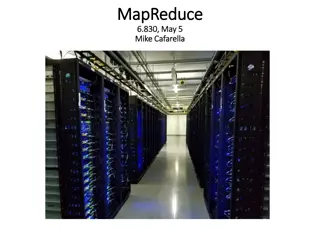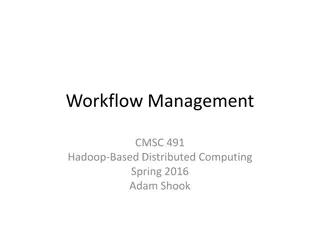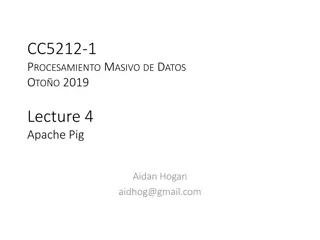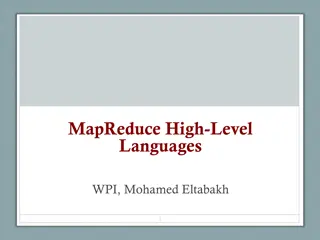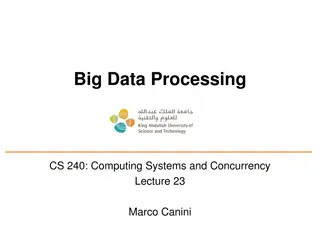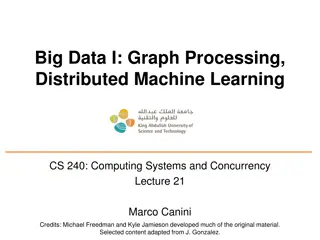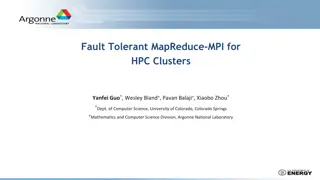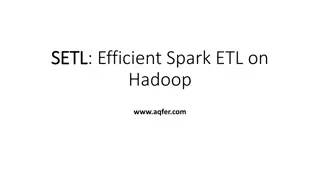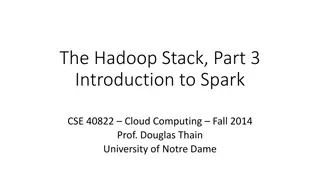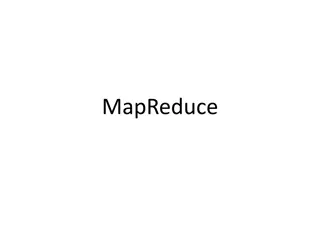
Understanding Map-Reduce in Distributed Systems
Explore the fundamentals of Map-Reduce in distributed systems, from its history to key features like automatic parallelization and fault tolerance. Learn how MapReduce simplifies large-scale data processing and enables clean programming abstractions for efficient distributed computing.
Download Presentation

Please find below an Image/Link to download the presentation.
The content on the website is provided AS IS for your information and personal use only. It may not be sold, licensed, or shared on other websites without obtaining consent from the author. If you encounter any issues during the download, it is possible that the publisher has removed the file from their server.
You are allowed to download the files provided on this website for personal or commercial use, subject to the condition that they are used lawfully. All files are the property of their respective owners.
The content on the website is provided AS IS for your information and personal use only. It may not be sold, licensed, or shared on other websites without obtaining consent from the author.
E N D
Presentation Transcript
Distributed Systems Hadoop Papadakis Harris Department of Informatics Engineering TEI of Crete
Contents Map-Reduce Hadoop HDFS
Map-Reduce Functional programming on distributed processing Motivated by the need to process large amounts of data using hundreds (or thousands) of processors Data are critical for computing, positioning computing in the data location. Provide clean programming abstraction similar to functional programming. The interface deals with all execution details.
Map-Reduce History Developed by Google to simplify their data processing jobs on large data Details emerged from two published papers James Dean, Sanjay Ghemawat, MapReduce : Simplified Data Processing on Large Clusters, Proceedings of OSDI 04, 2004 Sanjay Ghemawat, Howard Gobioff, and Shun Tak Leung, Google File System, Proceedings of Symposium of Operating Systems Principles, ACM SIGOPS, 2004 Since Google s implementation is proprietary and not available to public, an Apache Project called Hadoop emerged as an open source implementation Primary Contributors: Yahoo!, Facebook
Example of need Processing web data on a single machine 20+ billions webpages x 20KB = 400+ terabytes A computer can read 30-35 MB / sec from the disk ~ Four months to read the internet ~ 1,000 hard disks just to save the web Even more to analyze the data It takes too long on a unique machine, but with 1,000 machines? <3 hours to run on 1000 machines But how long to program? What about overhead? Communication, coordination, recovery from machine failure Status report, Debugging, Optimization, Location Inventing the wheel: What should be done for each program!
Map-ReduceFeatures Automatic Parallelization and Distribution of Data Fault Tolerance Status and Monitoring Tools Clean Programming Abstraction
Programming model MapReduce 1. Read a lot of Data 2. MAP: extract something you need from each record 3. Shuffle and Sort 4. REDUCE: aggregate, summarize, filter or transform 5. Write the results Outline stays the same Map and Reduce change to fit the problem Model seems restrictive but it is Turing Complete. Multiple maps and reduces needed to solve a complex problem
Programming model MapReduce map (in_key, in_value) -> (out_key, intermediate_value) list reduce (out_key, intermediate_value list) ->out_value list
Parallelism Map functions run in parallel, create intermediate values from each input data set The programmer must specify a proper input split (chunk) between mappers to enable parallelism Reduce functions also run in parallel, each will work on different output keys Number of reducers is a key parameter which determines map reduce performance All values are processed independently Reduce phase cannot start until the map phase is completely finished
Data Locality Hadoop Master program creates tasks based on the location of the data. It tries to send the map tasks to the same machine (or at least same rack) with the data that will be processed. Map inputs are divided into 64 MB blocks Minimizes communication at the network level
Fault Tolerance Hadoop Master program keeps track of progress of each task If a node fails, it re executes the task on other node that is alive If particular input key/value pairs keep crashing they are blacklisted and skipped from re execution Tolerate small failures, allow the job to run in best effort basis For large datasets containing potentially millions of records, we don t want to stop computation for a few records not processing correctly User can set the failure tolerance level
Hadoop What is Hadoop? Open Source Implementation of Google Distributed Computing Includes Open Source Implementations of MapReduce, BigTable, GFS . . It is supported by the Apache Foundation Primary Collaborations - Yahoo !, Facebook It is used by Yahoo to run on a 2000+ nodes, and many other web companies.
Hadoop Map-Reduce Implementation of Google s MapReduce Programming Model Express complex tasks in the form of Maps and Reduces to enable large scale processing of data enefits: Automatic Parallelization and Distribution of Data Fault Tolerance Status and Monitoring Tools Clean Programming Abstraction
Data Types Input/Output Writable Class Type for writable data as bytes (Serialization) IntWritable, Text etc All values must be Writable You can create your own Writable data type Class WritableComparable (subclass of Writable) Required for sorting by Reducers All keys must be WritableComparable
Reducer class The Reducer class is executed for each key generated by the mapper, we use the Iterator class to run the values of each key You can perform the required reduce function in the value of each key and create key / value pairs at will.
A Simple Program Lets try to write a Hadoop program that counts the number of even and odd numbers in a list Input: Text File with one integer value per line Output: Text File Containing the number of even and Number of Odd numbers in the Input file Mapper: Read each line, and create a pair of key/value ( even/odd , 1) for the line number Reducer: Sum up all the values of each key (even/odd) The end!
How a job is executed in Hadoop? MapReduce job is submitted to JobTracker masternode. JobTracker creates jobs and send them to TaskTrackers nodes. Each TaskTracker creates task instances for each job and executes them, reports on their status and sends results back to JobTracker.
HDFS Hadoop Distributed File System (HDFS) is a distributed file system designed to run on low-cost hardware. It has many similarities to existing distributed file systems. However, differences from other distributed file systems are important. Very tolerant to faults. It provides quick access to application data and is suitable for applications that have large data sets. Loosen some POSIX requirements to allow streaming access to system data files. Part of Apache Hadoop Core project. Project s URL is http://hadoop.apache.org/core/.
HDFS Architecture HDFS has data block size typically 64MB. The NTFS (Microsoft) and ext4 (Linux) filesystems typically have only 4 KB. - Small files (significantly smaller than 64MB) are a big problem for HDFS designed to handle huge files efficiently HDFS provides reliability by copying data to more than 1 node
HDFS Architecture Master Node in HDFS has the role of NameNode. NameNode keeps a variety of metadata for the file system such as the index that describes where each file or chunk is located, ie in which node. The remaining nodes have the role of DataNode, ie they store the data.





